Even these notorious “butcher birds” have their tender moments.
Loggerhead Shrikes are often called butcher birds because of their tendency to impale prey on thorns or barbed wire and then use the leverage provided by the anchored prey to pull it apart into bite-sized pieces. They’re fierce little predators, not much larger than a typical sparrow but they often take prey nearly as large as themselves including small songbirds, voles and lizards. I know from experience that to watch them eat can be a gory spectacle.
But yesterday morning on Antelope Island I photographed two of them in a rare tender moment.
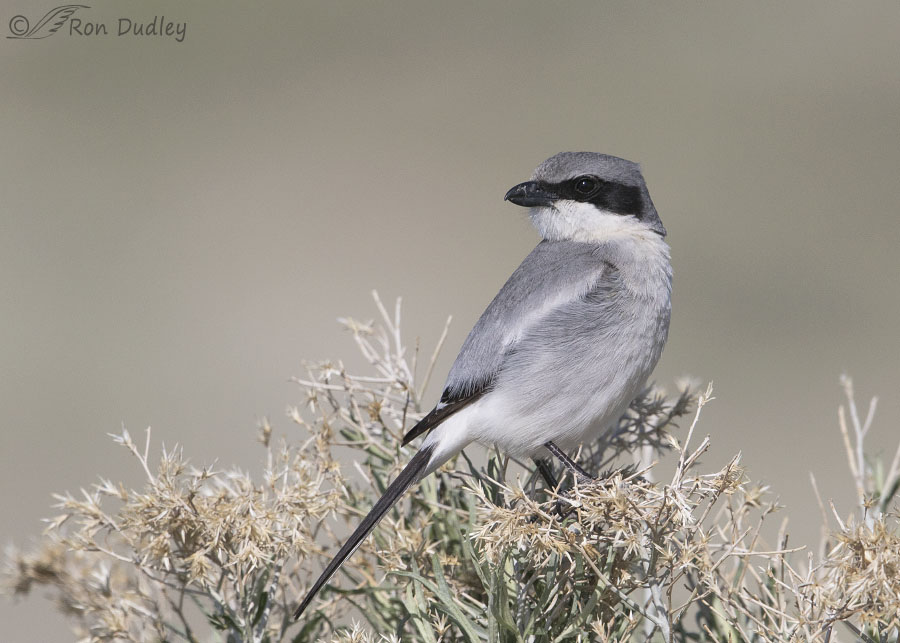
1/8000, f/6.3, ISO 640, Canon 7D Mark II, Canon EF 500mm f/4L IS II USM + EF 1.4 III Extender, not baited, set up or called in
Loggerhead Shrike sexes are similar but for reasons that will soon become evident this bird is a female. She perched here for quite a while and as she’s doing here she often looked behind her in the direction of another shrike some distance out of frame to the left. I was aware of the presence of the second shrike but couldn’t see what it was doing while I was watching her through my lens.
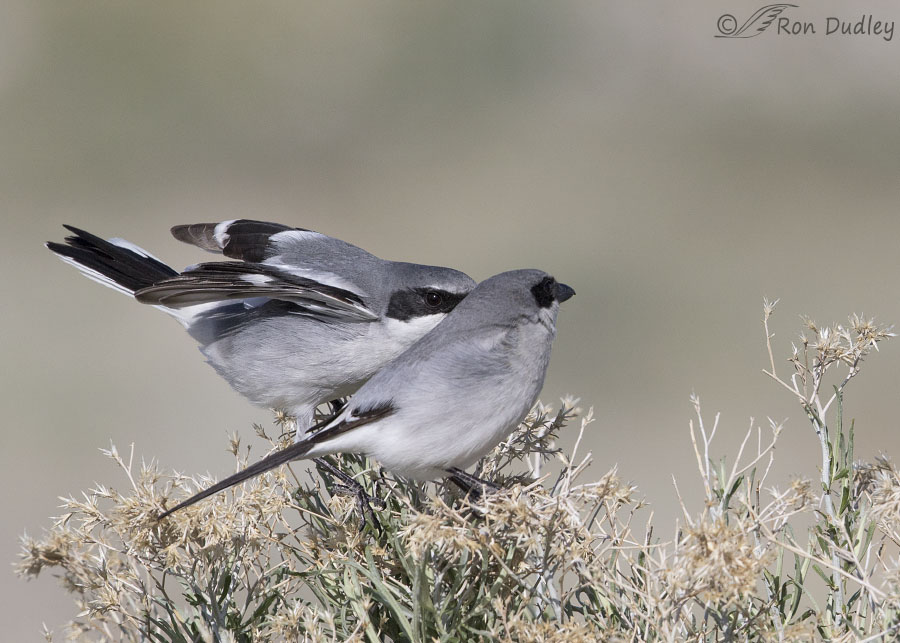
1/5000, f/6.3, ISO 320, Canon 7D Mark II, Canon EF 500mm f/4L IS II USM, not baited, set up or called in
When the second bird unexpectedly appeared in my viewfinder I instinctively laid on my shutter button and this was the first sharp shot I got just as the second shrike (a male) landed next to her.
He was bearing gifts.
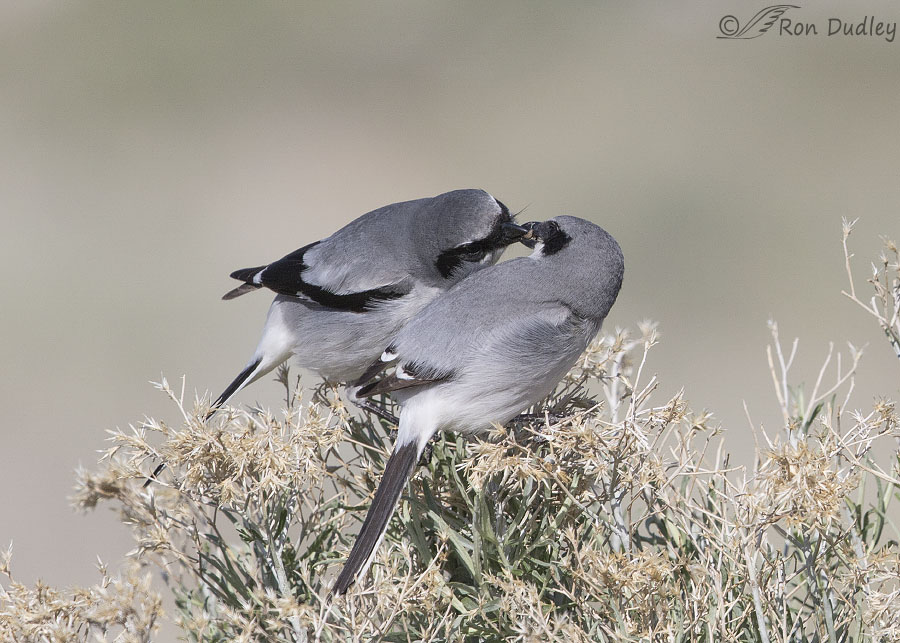
1/4000, f/6.3, ISO 320, Canon 7D Mark II, Canon EF 500mm f/4L IS II USM, not baited, set up or called in
He had food in his bill (when I blow up this image it appears to be an insect grub) which he presented to her and she immediately gobbled down. I didn’t have a very good angle on their faces but in this photo the food exchange is obvious.
When Loggerhead Shrikes are courting each other the female accepts prey from the male in a process called “courtship feeding” (thus the female is the bird on the right). This behavior continues throughout the incubation and nesting period so I don’t know how far their relationship had developed at this point but they were clearly either courting or strengthening a pair bond that had already been established.
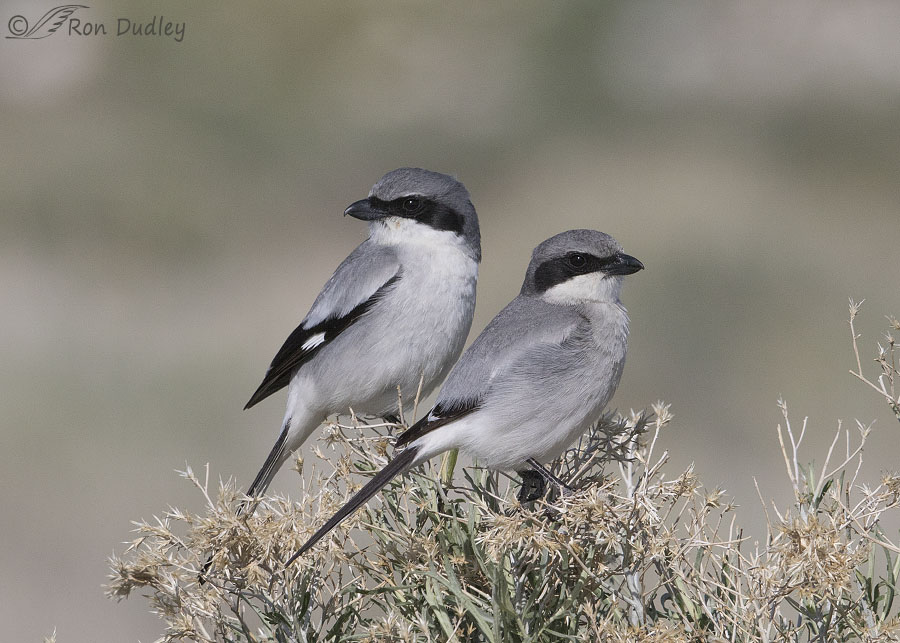
1/2500, f/11, ISO 500, Canon 7D Mark II, Canon EF 500mm f/4L IS II USM, not baited, set up or called in
After the food exchange they posed nicely together for some time. Males are somewhat larger than females and that size difference is obvious here.
In situations like this the use of a teleconverter has its advantages and disadvantages. For most of the time I was shooting these shrikes I wasn’t using mine and that gave me more depth of field to get two birds relatively sharp but the tradeoff was a little less detail than I’d have had if I’d been using it.
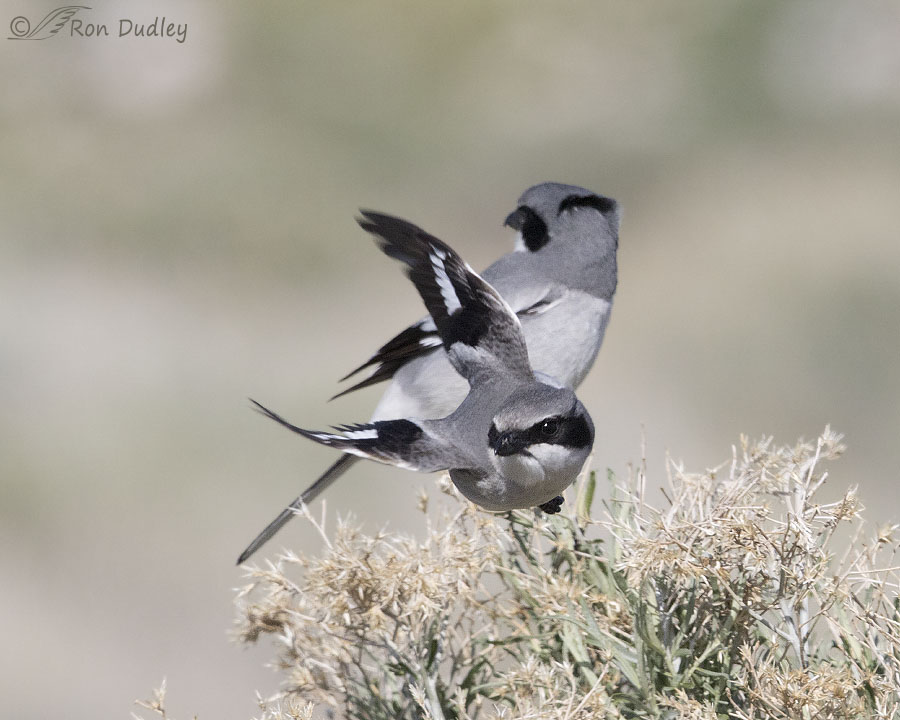
1/2500, f/11, ISO 800, Canon 7D Mark II, Canon EF 500mm f/4L IS II USM, not baited, set up or called in
But I didn’t have enough DOF for a shot like this one so neither bird is as sharp as I’d like but I still think it’s an interesting photo.
Loggerhead Shrikes have unusually large heads (loggerhead means “blockhead”) and that fact is obvious in this perspective on the female as she flies head-on toward the viewer.
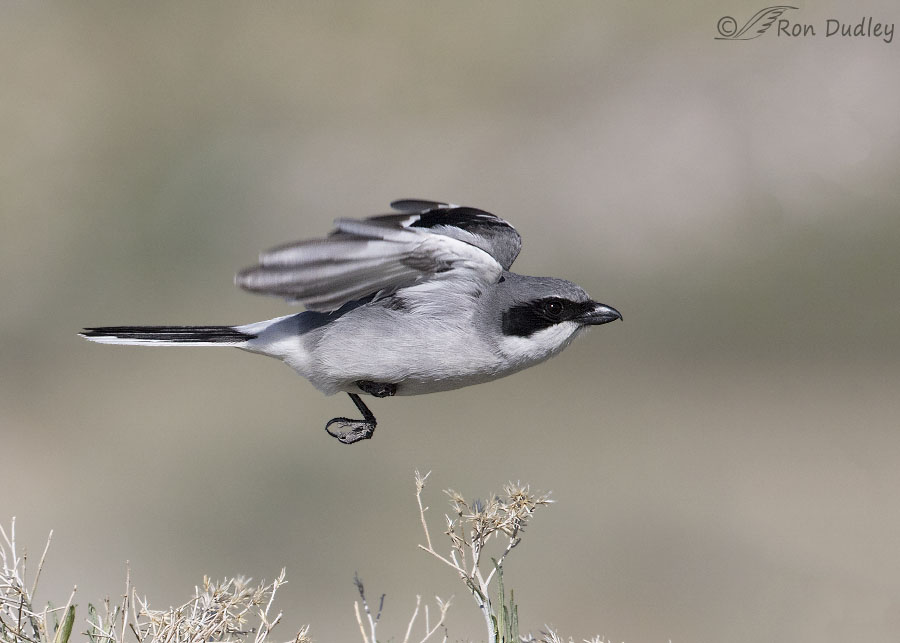
1/8000, f/7.1, ISO 800, Canon 7D Mark II, Canon EF 500mm f/4L IS II USM, canvas added for composition, not baited, set up or called in
Soon after the female took off toward me her mate launched to my right. I had to add canvas on the right for composition which I don’t like to do but for me shrike flight shots are quite difficult to get so I wanted to “save” this one.
It’s been a very long time since I’ve had any good opportunities with shrikes so I really enjoyed my session with these “wannabe raptors” yesterday morning.
Ron
Note to locals about a disturbing trend on Antelope Island:
Yesterday morning we found about a dozen gulls dead on the ground in a very small area on the north end of the island. They had no visible injuries and they appeared to have only recently died. I reported what we’d seen to a park employee and asked her if park officials were aware of the situation. She said they’d had reports of dead grebes in large numbers and they were “investigating” but this was the first report of dead gulls. She said she’d report our finding to appropriate park personnel.
Dead grebes sounds like it might be an outbreak of botulism but I’d be slightly surprised if that’s what’s killing gulls. Time will tell but whatever the cause it’s a disturbing trend.
Also, locals should be aware that the biting gnats (no-see-ums) are now out in full force on the island. Little bastards!


Absolutely beautiful shots, even the one where both birds aren’t sharp.
Ron,
I saw the gulls you mentioned yesterday. I was curious and thought to ask you on your blog but, as always, you are way ahead of me. Please report if you are informed of the cause.
Signed,
Curious and Concerned…
Another splendid series. As I scrolled through, reading your text, each shot made me gasp in delighted pleasure! Loggerheads are wonderful birds, but I’m a little surprised they’re not included in birds of prey. Anyway, that courtship behavior always warms my cockles!
Waiting for H3 to hatch. S/he is working the problem and should be out and about soon. And that’s good since her/his siblings are already bonking each other until Mom intervenes with a meal and/or an enforced naptime! And what Mom says goes!
I also hope whatever is killing these birds is discovered and mitigated/eliminated immediately if not sooner!
Also, having trouble getting the email to confirm my follow of this post. Sometimes computers suck!
Laura, I suspect a primary reason they’re not classified as “birds of prey” is that they don’t have talons.
And yes, computers suck all too often!
I see that it is time to increase my holdings in Calamine Lotion stock! 😉 Hope the “itchy-scratchies” aren’t too terrible for you and Mia. I sure appreciate you braving the little bastards for us, though!
I’m not sure which shot is my favorite — the Kissing (yes, I know it’s a feeding shot, but it looks like a smooch) Shot (#3) or the Takeoff Shot (#5). They’re both pretty amazing, as is the last one.
And please keep us updated if you find out anymore about what’s getting the Grebes and Gulls. I hope it is something that can be contained soon.
Thanks, Marty. Yes, I’ll update here if I learn anything more.
This is a truly heart melting series. Proof positive (to those who ever doubted it) that affection is not limited to our species. Followed by very disturbing news. I am glad that you are confident a reason (and hopefully a solution) can be found.
EC, I’m more doubtful of a solution than a reason. Often these kinds of things just have to play themselves out.
Fingers and toes crossed. If it is a ‘play it out’ scenario sobeit. Hopefully it isn’t something which could/should be stopped. Instantly if not sooner.
What EC said!
An Interesting and informative series…but disturbing info about gulls and grebes…almost sounds like poisoning….sure hope they figure it out soon…
I’m confident they will, Patty.
These are great pictures! I have only seen a Loggerhead and Northern Shrike once in my life. From my standpoint you are very lucky to witness this behavior. However, I suppose where they are common it would be s normal occurrence.
I have heard of botulism downing many birds at once. Very sad! Hope it isn’t more than that.
I don’t know how common the behavior is, Dick. Of the many hundreds of times I’ve photographed shrikes I think this is the first time I’ve documented photographed their courtship feeding.
During bad outbreaks of botulism around here it isn’t uncommon for many thousands of birds to die from it.
Great photos Ron. You have given me an education this morning. I have taken Loggerhead Shrike photos here and had no idea they were predators. I have only seen them perched in trees – never in action.
Everett Sanborn, Prescott AZ
They’re very efficient predators, Everett. One of my dream shots is to get a shrike in flight carrying a vole. I came very close to getting that shot once but things didn’t work out for me. A friend got the shot though.
What a wonderful series Ron! Thanks for sharing!
Charlotte
Thank you, Charlotte.
Botulism does not usually occur until we hit high temperatures in the 90 degree range. It is more likely to be avian cholera, we often have bouts of it with grebes in the fall and winter months. I wonder if park biologist will send off samples to the national lab?
Beautiful photos of the happy shrike couple. I really like the 4th photo.
I’m sure they will, April – probably have already with some of the grebes. They usually try to get to the bottom of this kind of thing pretty quickly.
Ron, a possibility is West Nile Virus. We had an outbreak here, with dead crows being most visible but per this link several species have been infected and thing to do is contact USDA. https://www.cdc.gov/westnile/dead-birds/index.html.
Yeah, west nile, avian cholera, botulism – it could be any of a variety of causes, Martha. The park is “investigating” so I’m confident they’ll be sending some of the birds into the lab. They’ve done that in the past.
Great shots as usual! And one of my favorite species. I don’t know if you’ve tried Permethrin on your clothing, but I highly recommend it. Sawyer makes the ready-to-spray stuff, but it’s more economical to mix your own. About this time of year, I usually mix a large patch and spray down all my outdoor clothing. It’s good for a few washings.
David, I’ve bought long sleeved shirts that have been treated with that stuff but it doesn’t seem to make a difference. Park personnel say that the only repellant that’s effective on the gnats is Green Goo so I’m going to give it a try.
Fortunately, we don’t have a lot of gnats here. I’ve never tried the pre-treated fabrics, but can say that treating your own with permethrin is very effective versus chiggers and ticks particularly. It also somewhat helps repel mosquitoes and definitely keeps them from biting through the fabric, but I still spray my bare skin with Off. So I guess I shouldn’t be too surprise that it’s not effective versus gnats.
Absolutely love these photos and their story! That fourth picture…perfection! (I really love the muted tones that you are able to achieve in the background of so many of your photos.) I have never had the pleasure of seeing this bird yet. Sorry to say though, I grew up with ‘no-see-ums’ in MI. so I’ve had more bites than I care to remember!
I’m glad you like that 4th photo, Kathy. I think it’s pretty special.
Glad you got the time with the shrikes – we don’t often see them here but they do clear out the feeding area when they show up! Beautiful photos of them even if not “perfect” 😉 It is unnerving to find a group of dead birds with no obvious reason for their demise………:( No-see-ums are NEVER fun to encounter! Fortunately we don’t often have them here!
I don’t remember biting gnats on our Montana farm either, Judy. Plenty of skeeters though…